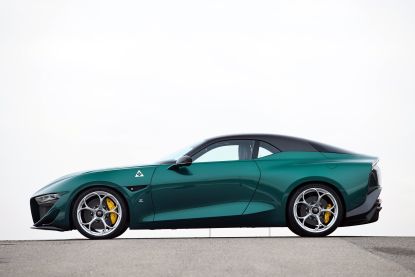New Alfa Romeo Giulia SWB Zagato honours a century of collaboration
Built in an edition of one, this striking Alfa Romeo Giulia SWB Zagato showcases the art of one of Italy’s finest coachbuilders
- (opens in new tab)
- (opens in new tab)
- (opens in new tab)
- Sign up to our newsletter Newsletter

This is the Alfa Romeo Giulia SWB Zagato, a cracking reminder of what the company is capable of and a fulsome throwback to the heady partnerships of the 1950s, 1960s, and 1970s. This was the era of coachbuilding masterpieces, when the grand Italian styling houses found it in themselves to improve upon the already beautiful creations of companies like Ferrari, Alfa, and Lancia.

Sad to report, but this particular car is set to remain a one-off. Built for a German collector, the car broke cover just before Christmas 2022, an early gift for all those who still hold a candle for this golden era of car design.
The idea for the Giulia SWB originated in 2021, the year Zagato celebrated a century of collaboration with Alfa Romeo. A commemorative car was planned, drawing on Alfa’s current Giulia and Stelvio models, but in the form of a two-door coupé – a niche that is sadly absent from today's Alfa Romeo line-up.

The new Zagato is based on the acclaimed Giulia Quadrifoglio performance model, with a shortened wheelbase (hence SWB) and bodywork formed from carbon fibre. The designated customer is a longstanding Alfaholic, as well as a fan of Aston Martin’s ongoing partnership with Zagato. His collection includes the Alfa Romeo SZ ('Sprint Zagato'), a quintessentially 1990s machine that took Alfa’s 75 saloon and transformed it into a brutish, stubby pocket supercar.

The new Giulia SWB Zagato alongside an original Alfa Romeo SZ at ‘La Pista’ circuit in Arese
Visually, the SWB incorporates many key Zagato design elements, from the pronounced forward-focused stance to the trademark ‘double bubble’ roof, evolved from the requirement for early closed racing cars to have space for crash helmeted drivers.

Zagato’s team worked closely with Alejandro Mesonero, vice president of Alfa Romeo Design, but all development and production were carried out in-house. The famous Alfa grille is low to the ground, flanked by a new iteration of Alfa’s current 3+3 headlight identity. At the rear, the abruptly cut-off tail is another tell-tale signature of the brand.

Zagatos have always had an awkward, almost gawky edge, evidenced not only by the Alfa Romeo SZ, but also by earlier models like the GT 1300 Junior Zagato from 1969 and the TZ3 Stradale created for Alfa’s own centenary in 2011. Fittingly, the one-off Giulia SWB Zagato is a convincing heir to a century of extravagant and individualistic automotive design.

We’ve often lamented that Alfa Romeo’s contemporary soul is somewhat lacking, condemned to wander the highways and byways of nostalgia whilst the famous badge ends up plastered all over unworthy SUVs. Perhaps another Zagato collaboration could help rekindle Alfa’s flame?
AlfaRomeo.co.uk (opens in new tab)
Zagato.it (opens in new tab)
Jonathan Bell has written for Wallpaper* magazine since 1999, covering everything from architecture and transport design to books, tech and graphic design. He is now the magazine’s Transport and Technology Editor. Jonathan has written and edited 15 books, including Concept Car Design, 21st Century House, and The New Modern House. He is also the host of Wallpaper’s first podcast.
-
 The Standard Bangkok and The Standard Hua Hin bring pioneering hospitality to Thailand
The Standard Bangkok and The Standard Hua Hin bring pioneering hospitality to ThailandThe Standard Bangkok, in Ole Scheeren’s Mahanakhon tower, and The Standard Hua Hin, designed by Onion, bring the global hospitality brand to Thailand
By Shawn Adams • Published
-
 These artists are putting their stamp on the ‘Lady Dior’ handbag
These artists are putting their stamp on the ‘Lady Dior’ handbagNow in its seventh edition, ‘Dior Lady Art‘ invites international artists to reimagine Dior’s Lady Dior handbag – one of the house’s most memorable styles
By Jack Moss • Published
-
 Watch Ryuichi Sakamoto's mesmerising musical experience at the Brooklyn Museum
Watch Ryuichi Sakamoto's mesmerising musical experience at the Brooklyn MuseumAn iconic composer who traverses popular and high culture, Ryuichi Sakamoto pushes music into new frontiers, most recently in ‘Seeing Sound, Hearing Krug’, a new composition that pairs sound, flavour, light and texture
By David Graver • Published


